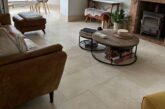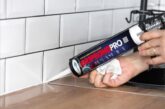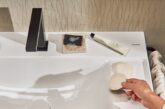
Garry Gregory, packed products director at Tarmac explains why the right tile adhesive can make all the difference to your customer’s projects.
Your customers will have spent a long time choosing the perfect tile for their space and it’s important to use the most suitable tile adhesive to ensure they remain looking perfect. Tile adhesives can be used for fixing a wide range of tiles and stones over different surfaces. The solution is prepared to blend and prevents shrinkage, breakages and will ensure the tiles don’t slip.
Most of the time you will require different adhesives for walls and floors but there are some that are suitable for both. But how do you know what type of adhesive is right for the job? And why is it so important to get it right?
How to choose the right solution
When choosing your tile adhesive, the type of tile you are fitting needs to be the first consideration before looking at where the tile is going to be fit and what material the surface is.
For instance, tile adhesives are flexible with thermal and physical movements and can be used with all types of tile and stones without the need for the tiles to be soaked beforehand, making it suitable for a wide range of applications. However, there are a number of different types which have been tailored to meet the specific needs of certain applications and, therefore, it’s important to know the difference:
- Ready mixed adhesives – ideal for tiling areas such as kitchen splashbacks where levels of moisture are lower. However, this should never be used when fitting porcelain tiles due to the non-porous surface, or when installing any floor tiling.
- Rapid set multi-flex adhesives – this should be used when fixing all types of ceramic and porcelain tiles to walls and floors in interior and exterior locations.
- Standard rapid cement – this should only be used when fixing glazed ceramic tiles that are larger than 30cm x 30cm to a solid wall or floors.
It’s important to understand all of the above before purchasing your chosen tile adhesive. If the wrong one is selected, it could lead to tiles cracking, moving or coming loose, which could lead to customer complaints and returning to the job to fix any mistakes.

Once you have worked out which type of tile adhesive is right for your project and how much you will need, it’s time to look at how to prep the space for the perfect installation.
Fail to prepare, prepare to fail…
Thorough preparation is crucial if you want the tiles to be laid properly and to a high standard. Here are some simple steps to ensure a successful finish:
- Always ensure your equipment and the application is clean, dry and free from any dust and debris before you start tiling – this means that nothing will affect the bonding ability of the tile adhesive.
- Tile adhesive can set quickly and so always spread the tile adhesive on small areas first to ensure it doesn’t dry out before you have chance to apply the tiles.
- Don’t forget to check the floor level before you start – this is especially important if you are applying floor tiles or if you are installing wall tiles that begin at floor level. You don’t want to apply tiles on a slant!
- Check the consistency and quality of the tile adhesive before applying it to the surface. If it’s too runny, it won’t hold as well and if it’s lumpy then the tiles won’t lay flat.

Maintaining a high standard
Positive customer testimonials often refer to jobs that have been completed on time with the property left clean and tidy, which can be achieved by working efficiently and carrying the right tools and materials for the job. Tilers will always carry tile adhesive in the back of their van. However, for those jobs where you need to move a lot faster, a faster setting solution, such as Tarmac’s Blue Circle Masterlay Rapid Set Tile Adhesive is often required.
We know that builders put a lot of pride in their work and always aim to complete jobs to the highest standard. Therefore, it’s important to select a highly workable and cohesive, good-quality adhesive that can be a great asset to anyone looking for a more durable, yet convenient solution for their projects.
For further information on Tarmac Blue Circle Tile Adhesives visit Entrance – Tarmac (tarmac-bluecircle.co.uk).







